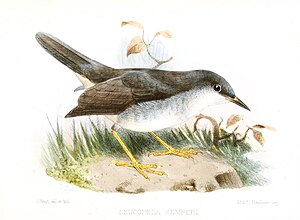Pale-footed warbler
| Pale-footed warbler | ||||||||||||
|---|---|---|---|---|---|---|---|---|---|---|---|---|

Pale-footed warbler ( Leucopeza semperi ) |
||||||||||||
| Systematics | ||||||||||||
|
||||||||||||
| Scientific name of the genus | ||||||||||||
| Leucopeza | ||||||||||||
| PL Sclater , 1876 | ||||||||||||
| Scientific name of the species | ||||||||||||
| Leucopeza semperi | ||||||||||||
| PL Sclater, 1876 |
The pale-footed warbler ( Leucopeza semperi ) is an extremely rare or already extinct songbird from the forest warbler family . It is or was endemic to the island of St. Lucia and is the only known species of the genus Leucopeza. The generic name is the Greek derivative of the Creole name pied blanc and means "white feet". The specific epithet honors Reverend John E. Semper, who collected the type specimen in the 1870s.
description
The pale-footed warbler reaches a length of 14.5 centimeters. The plumage of the adult birds is dark gray on the top and gray-white on the underside. The young birds are brownish-gray on top and yellow-brown on the underside. The legs are light yellow. The call consists of tones that sound like tuck-tick-tick-tuck .
Habitat and way of life
The pale-footed warbler lives in the undergrowth of mountain forests. Nothing is known about his way of life; but it is probably a ground breeder.
status
The pale-footed warbler was still fairly common in the 19th century, but there are only a handful of observations from the 20th century. According to ornithologist James Bond , one of the leading experts on Caribbean avifauna , a female was shot in 1934 on the summit of Piton Flores . Another individual was sighted between the Piton Lacombe and the Piton Canaries in March 1947 . The last reliable evidence is from 1961. Although there was only unconfirmed evidence in 1965, 1972, 1989, 1995 and 2003, there is little hope of a rediscovery as some untouched forest areas are still present. The reasons for its decline were probably introduced mongooses and habitat destruction .
Individual evidence
- ↑ James Cowan Greenway : Extinct and Vanishing Birds of the World. 1967.
literature
- Philip Lutley Sclater: Some Additional Species of Birds from St. Lucia, West Indies . In: Proceedings of the Zoological Society of London. 1876, pp. 13-14.
- Scott Weidensaul: The Ghost With Trembling Wings: Science, Wishful Thinking, and the Search for Lost Species. Northpoint Press, 2002, ISBN 0-374-24664-5 .
- James Greenway: Extinct and Vanishing Birds of the World. Dover Publications Inc., New York 1967, ISBN 0-486-21869-4 .
- John Curson: Family Parulidae (New World Warblers). In: J. Del Hoyo, A. Elliot, D. Christie (Eds.): Handbook of the Birds of the World. Volume 15: Weavers to New World Warblers. Lynx Edicions, 2010, ISBN 978-84-96553-68-2 , p. 777.
- Michael Walters, Julian Pender Hume: Extinct Birds. Poiser Monographes (A & C Black), 2012, ISBN 978-140-815-725-1 , p. 318.
Web links
- Leucopeza semperi in the endangered Red List species the IUCN 2008. Posted by: BirdLife International, 2008. Accessed on December 20 of 2008.
- Birding In St. Lucia ( Memento from October 6, 2008 in the Internet Archive )
- BirdLife Species factsheet